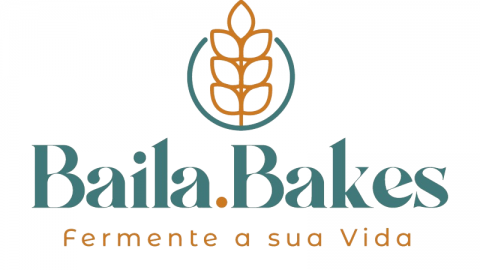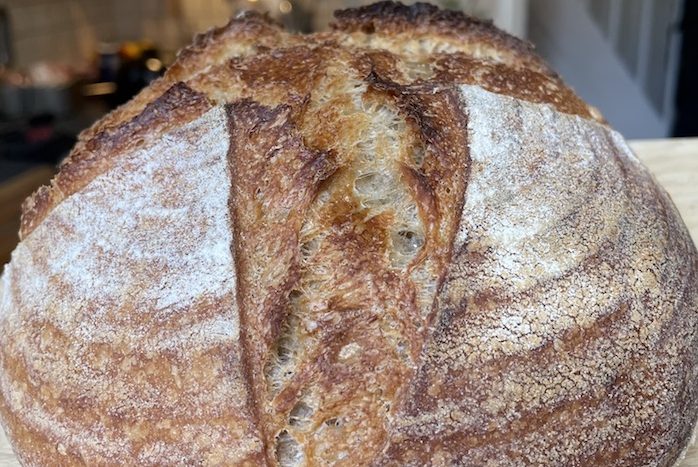With this recipe and a little practice you can make your first bread. But attention! To make this recipe you will need active natural yeast.
What utensils do you need
- a big bowl
- a scale
- A baker's spatula
- An iron pan or a large Pyrex dish
- A baker's blade (if you don't have one, you can use a razor blade, a sharp knife)
- A banneton or a bowl that you can use for the bread to rise
- An oven that reaches temperatures of at least 250C
How important is flour?
The flour will influence the result, but be sure to make your own bread if you don't have access to strong flours. The important thing is to practice. In that case, reduce the amount of water.
some touches
- The natural fermentation process is slow and requires patience, but the flavor makes up for it.
- Weigh the ingredients accurately. Use a scale.
- To get a crispy crust and soft crumb, it is necessary to develop gluten in the dough. There are several techniques that help with the formation of gluten with autolysis, folding and of course the final fermentation in the fridge.
- The oven temperature should be very high (from 250 -230C). In the first 20 minutes with the lid and then without the pot lid (or pyrex).
Natural fermentation bread for beginners
1
breadIngredients
240g bread flour or strong flour
60g wholemeal flour
210g Filtered or mineral water (you can reduce the amount if your flour does not support it)
60g Active Levain (1:1:1 – equal parts flour, natural yeast and water)
6g of salt
Directions
- Dissolve the yeast in the water with your hands.
- Add the flour and mix well until there are no dry parts left. Cover the bowl.
- Rest the dough for an hour.
- Add the salt. Mix well (4 to 5 minutes) until you are sure the salt has been incorporated. Cover the bowl again and rest for another 30 minutes.
- Primary Fermentation
- Do 3 series of folds (strecht & fold) with intervals of 30 min. Watch the dough rise. If the temperature in the kitchen is high (above 26C), fermentation can be faster.

- At the end of the 3rd fold, control the veil stitch. Stretch a point of dough with two hands in opposite directions and check if an elastic membrane has been created. If you haven't reached that point, wait another 30 minutes and make another fold.
- Let the dough rest for approximately 2 hours. Everything will depend on the temperature of your kitchen. Control the volume of the dough. It should grow from 25 to 50%.
- Pre-modeling
- The dough has risen and is ready to be pre-shaped. Pour the dough onto a surface. At this point there is no need to sprinkle with flour. To make it easier, you can spray it with water. Fold over itself in all directions, gather all the ends in the center, make a ball and turn the dough. With light circular movements. Model a ball and wait 15 to 20 minutes for the dough to relax.

- Final Modeling
- Prepare a banneton, sprinkling it with brown rice flour.
- Make the final modeling and place the dough in the banneton. Cover and refrigerate for 12 to 24 hours.
- Baking bread (Coction)
- Preheat the oven to 260C and heat the pan for at least 30 minutes
- Take the dough out of the fridge and cut it with a baker's blade.
- Place immediately in the pot, but first spray water on the lid on the pot to create more steam.
- Bake the dough for 20 minutes (250C) with the lid on
- Remove the lid and bake for 15 to 20 min (230C – 220C). Depending on your oven and the desired color,
- Cooling
- Let it cool completely. At least for 2 hours
- Afterwards, just taste! Can be frozen for up to 3 months
Notes
- remember that everything will depend on your kitchen conditions such as the temperature of the room and your oven.

























How much salt would be recommended for this recipe?
Gratitude for sharing the recipe and for the site, lots of quality content
Hi Cleber, the amount of salt is 6g. Thank you for pointing out the missing ingredient. I've already corrected. Check back often!
Oi boa tarde, já faço Pão com fermentação, mais ainda erro bastante, gostaria de saber qual a temperatura ideal da geladeira , e qto tempo sovar na ou na batedeira, a farinha brasileira não é tão boa qto aí na Europ
Olá Maria das Graças, a temperatura da geladeira vai variar de acordo com o esteagio de fermentação da sua massa. Mas em média, dee 5 a 7C. Quem vai dizer o tmepo das dobras é a massa e nõa a receita. O ponto de véu uma boa indicação de que o glúten está bem desenvolvido